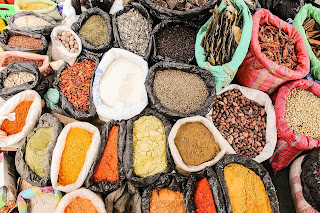The Bishop's Herb Ajwain
The Bishop's Herb
Hindi name: Ajwain
botanical name
Trachyspermum amoni (L.)
Surname
Sprague Apiaceae
Commercial part
fruit
Originating within the eastern Mediterranean, perhaps Egypt, and now cultivated on an outsized scale within the Persian and Indian regions, the utilization of ajwain in cooking and as an Ayurvedic remedy is limited to Central Asia and northern India. However, in the Arab world and as a mixture of Ethiopian spices, ajwain has some popularity.
The most used part of Bishop's Weed are the small caraway fruits that have the essential oil (2.5 to 5% in dried fruits) dominated by thymol (35 to 60%); a- pinene, p-cymene, limonene and? -terpinene as its main components.
Also known as ajwain, Bishop's Weed is an aromatic spice with a wonderful flavor. Traditionally, India has been one of the most important sources for Bishop's Weed with Rajasthan and Gujarat as the main producing regions. Grilling or frying in combination with potatoes or fish enhances the strong aroma of Bishop's Weed. However, legumes (lentils, beans) are the most important field of application; In India. In South Indian cuisine (which is predominantly vegetarian), tadka (frying in butter or butter) is applied not only to dried legumes, but also to vegetables and boiled rice.
Ajwain is widely used as a medicinal plant in Ayurvedic (Indian) medicine to help against diseases of the digestive tract and less.
Name in international languages
Latin: Trachy Spermum Ammi
Persian: Zinian, Nankhwah
Arabic: Kamme Muluki
The Bishop's Herb
Hindi name: Ajwain
botanical name
Trachyspermum amoni (L.)
Surname
Sprague Apiaceae
Commercial part
fruit
Originating within the eastern Mediterranean, perhaps Egypt, and now cultivated on an outsized scale within the Persian and Indian regions, the utilization of ajwain in cooking and as an Ayurvedic remedy is limited to Central Asia and northern India. However, in the Arab world and as a mixture of Ethiopian spices, ajwain has some popularity.
The most used part of Bishop's Weed are the small caraway fruits that have the essential oil (2.5 to 5% in dried fruits) dominated by thymol (35 to 60%); a- pinene, p-cymene, limonene and? -terpinene as its main components.
Also known as ajwain, Bishop's Weed is an aromatic spice with a wonderful flavor. Traditionally, India has been one of the most important sources for Bishop's Weed with Rajasthan and Gujarat as the main producing regions. Grilling or frying in combination with potatoes or fish enhances the strong aroma of Bishop's Weed. However, legumes (lentils, beans) are the most important field of application; In India. In South Indian cuisine (which is predominantly vegetarian), tadka (frying in butter or butter) is applied not only to dried legumes, but also to vegetables and boiled rice.
Ajwain is widely used as a medicinal plant in Ayurvedic (Indian) medicine to help against diseases of the digestive tract and less.
Name in international languages
Latin: Trachy Spermum Ammi
Persian: Zinian, Nankhwah
Arabic: Kamme Muluki


Post a Comment